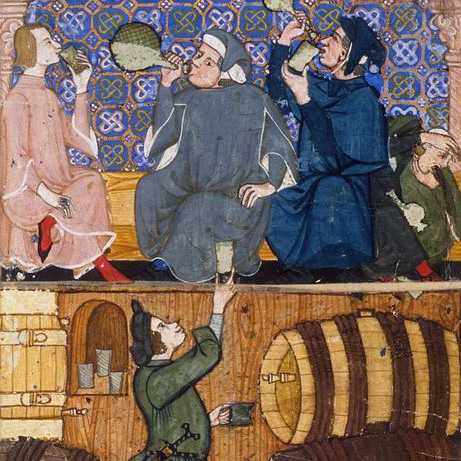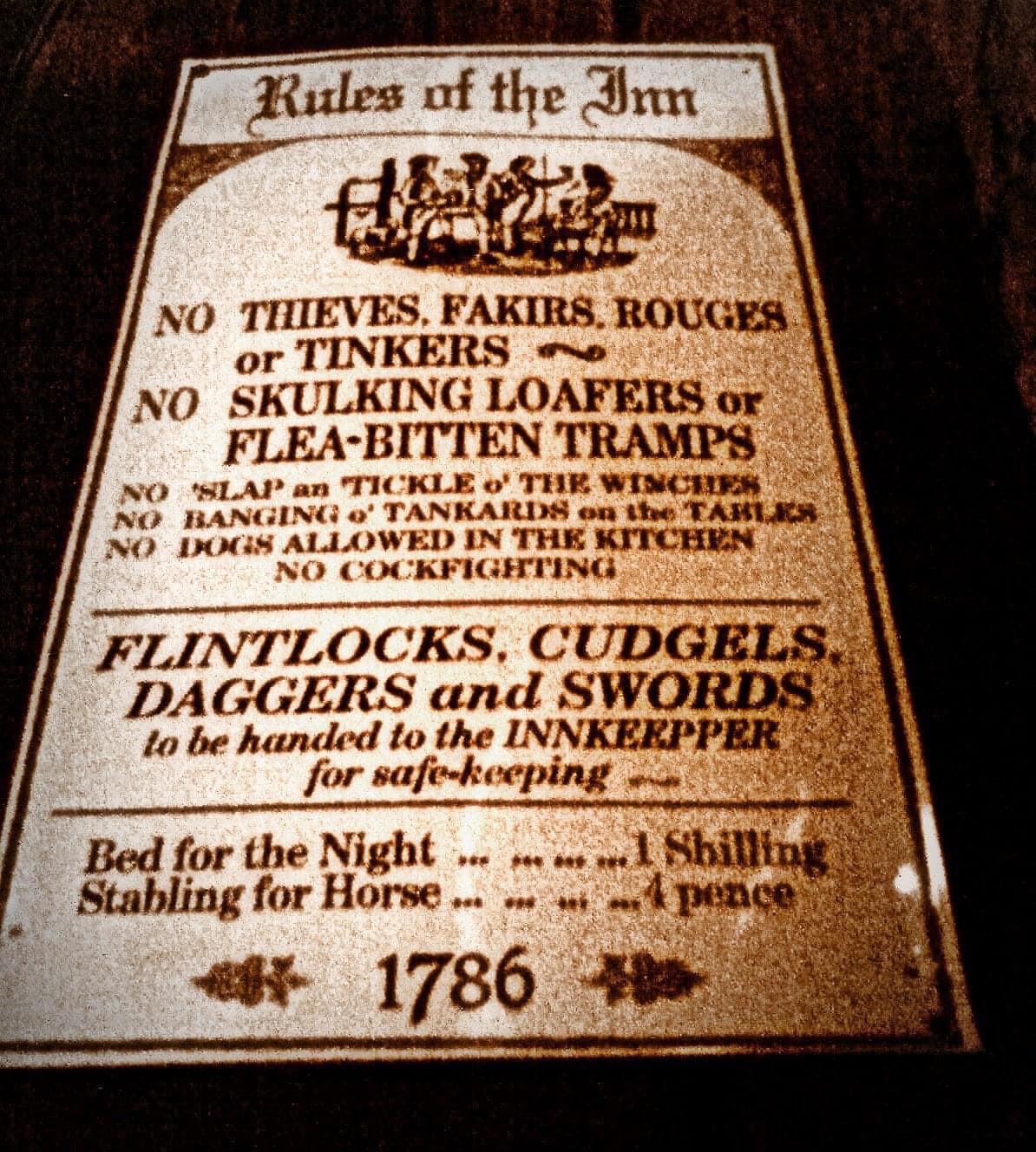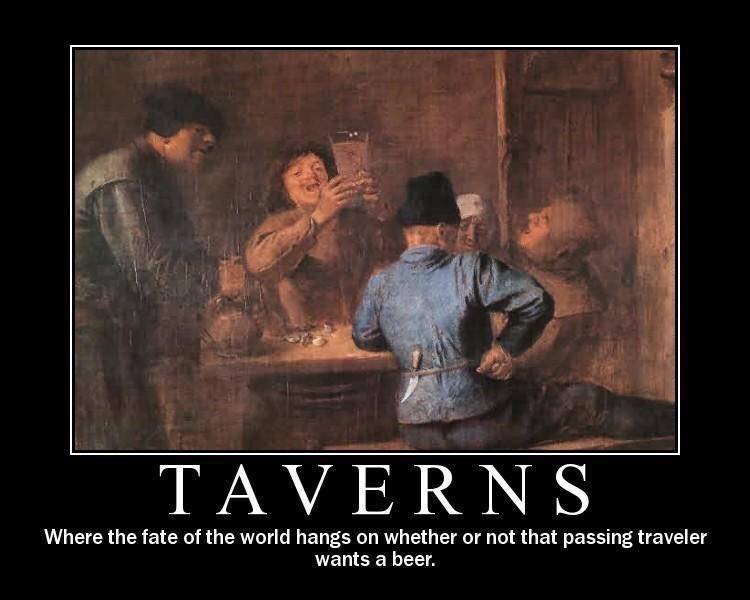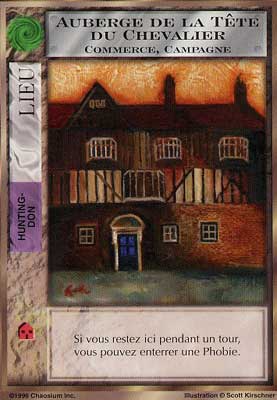| - | - | - | - | - |
| A Room For The Knight | Dragon 29 | - | Best of Dragon, Vol. II | Dragon |
Inns and taverns frequently
appear in Dungeons and Dragons
games, yet may not be utilized
to their fullest potential either by the DM
or the player characters.
The reason for this being the function of inns
and taverns is not fully
realized and they can be difficult to design and
stock. This article is presented
as an aid to DM’s and players whereby
the functions of inns and
taverns can be more fully realized.
The two terms “inn” and
“tavern” have become almost interchangeable in modern usage, however this
was not always the case. An inn, by
definition is a place where
travelers could obtain food and shelter, for a
price. A tavern can be considered
to be a place where ale (and other
drinks) would be served
in addition to food. An example of a tavern in
modern society would be
the English pub or public house. In some
instances an inn would have
a tavern on the premises, or within short
walking distance.
Small communities (population
1-150) would probably not have a
need for an inn. These small
communities might have a tavern (75%
chance) to serve as a community
center, as well as a place wherein
travelers could obtain food
and drink. For lodging, a traveler finding
himself or herself in a
small community as night fell would probably
either be forced to sleep
outside or beg shelter from the local residents.
Early in history, there
were no inns, so travelers and pilgrims would seek
shelter in the homes of
local farmers or townspeople. These solicitations
for shelter were frequently
successful, as travelers were an excellent
source of information about
the world outside the local community.
As communities became larger
(populations of 150-500), the concept of providing food and shelter to
travelers for money became more
common. Often communities
of this size would support from 1-10 inns,
depending upon their locations
on the trade routes. The closer the
community to a heavily traveled
trade route, the greater the number of
inns.
Large towns and trading centers
could support a number of inns and
taverns. While we do not
generally consider the medieval community as
being heavily populated,
one reference states that in 1453, Paris consisted of three square miles.
In these three square miles
there were
150,000 people and 5,000
inns and taverns.
The size of inns generally
ranged from 5-50 guest rooms, depending
upon the needs and location
of the community. As stated earlier, an inn
might have a tavern-type
area located within the inn proper or nearby.
For the maximum effectiveness
in a D&D campaign, a large number
of the rooms should be filled.
Some of the travelers could have come
from merchant
caravans (60%), or pilgrim bands (40%). Other guests
might include king’s messengers
bearing important documents, adventurers of various sorts, solitary high
level wizards, spies and an unlimited
amount of other characters
developed by the DM to add zest to the
game.
The cost for rooms would
range from 5 copper pieces to 5 gold
pieces per night or weekly
rates of between 5 to 20 gold pieces. These
rates would generally include
two meals per day. Drinks would not
usually be included in these
rates.
For one’s money, one gets
a bed, normally made up with clean
sheet and blankets—if not,
there is a chance (10%) of bedbugs, ticks or
disease. There may be bathing
facilities, but not normally after dusk, a
50% chance of laundry service,
a wash basin and a pitcher of water, and
directions to the nearest
outhouse. There is a 75% chance that the inn
will be able to feed and
shelter one’s horse (or whatever), for 5 silver to 1
gold piece per night. The
care one’s horse will receive would probably
include: walking it to cool
it off, washing it and brushing it down, and
feeding it
The chores around the inn
would generally be done by a youth
apprenticed to the innkeeper.
These apprentices were sometimes called
ostlers. Apprentices may
have been the sons of the innkeeper or other
youths who wished to learn
the trade of innkeeping. An apprentice
would remain in the master’s
service until his eighteenth birthday,
having begun the training
at about twelve years old. Their tasks include
work in the stable, the
kitchen and tavern. They would rarely be
involved in handling money
and did not tend the bar until the last years
of the apprenticeship. There
is a 25% chance that they are literate,
however most can perform
simple mathematical computations.
In addition to the apprentices
(1-4), there would be the innkeeper.
While innkeepers have become
stereotyped in literature as being short,
fat, balding men with notoriously
bad memories, this does not need to
be the case. Innkeepers
are male (95%); short (20%), medium height
(60%), or tall (20%). They
are thin (20%), average build (40%), or stout
(40%). They are normally
observant (a 70% chance of them being able
to remember every detail
of a particular event). They are not easily
deceived, though rarely
can they be considered clever. 50% of the
innkeepers are lawful, 20%
are neutral and 30% are chaotic.
Most innkeepers are married
(90%). In medieval society, women
were relegated to a secondary
role, involved in such activities as cooking
and sewing for the customers.
The innkeeper’s wife normally had from
one to five young women
to assist her with her tasks. These young
women also milked the cows
and assisted with the other chores, such as
gathering eggs. These young
women sometimes act as waitresses, and if
the innkeeper is chaotic
there is a 25% chance that these young women
might provide other, more
infamous, activities for the customers (1-5
gold
pieces per night). If the innkeeper isn’t chaotic in nature and
a guest
propositions one of the
young ladies in his charge, beware the loaded
crossbow under the bar.
The activities of the inn
or tavern centered around the common, or
public room. It is in these
areas, that your players will take their meals
and mingle with the other
guests and townspeople. Common rooms
would be large, at least
40’x30’, and have a seating capacity for at least
60 people. Some common rooms
will be dark and dim, while others will
be brightly lit and cheery.
It all depends on the owner.
Food prices will vary
as will the types of food available. Below is a
listing of some of the food
items commonly found in various D&D
taverns, with approximate
prices.

MEALS
| Beavertails | 5 sp |
| Snake Stew | 5 sp |
| Rabbit Stew | 3 sp |
| Wolf Stew | 3 sp |
| Chicken Eggs | each 3 cp |
| Lizard Steaks | 2 gp |
| Beef Steaks | 10 sp |
| Roast Chicken | 5 sp |
| Roast Duck | 8 sp |
| Ham | 5 gp |
| Haggis | 5 sp |
| Salad (lettuce) | 4 cp |
| Lobster | 2 sp |
| Shark | 3 gp |
| Fried Snake | 3 sp |
| Frog Legs | 1 sp |
| Otter Stew | 15 sp |
| Snake Eggs | 5 gp |
| Duck Eggs | 11 sp |
| Eel Steaks | 4 gp |
| Roast Turkey | 3 gp |
| Roast Pheasant | 5 gp |
| Venison | 6 sp |
| Mutton | 4 sp |
| Vegetables (potatoes, etc.) | 3 cp |
| Crab | 3 gp |
| Caviar & Salmon | 6 sp |
| Whale Blubber | 10 gp |
| Beef Ribs | 8 sp |
| Bread | 5 cp |
DRINKS
| Wine, good | 15 sp |
| Wine, watered | 10 sp |
| Mead | 10 sp |
| Ale | 3 sp |
| Grog | 4 sp |
| Rum | 8 sp |
| Beer | 8 sp |
These are priced for a 16 oz. tankard
This list includes many of
the items typically found on the menu of an
inn or tavern. This, of
course, depends upon largely the locale of the inn
or tavern.
The common rooms not only
served as a place for guests to partake
in eating and drinking,
but also as a gathering place for the townspeople.
As a focal point for the
local people and the travelers staying there, the
common room was a place
where news of the world could be shared.
The common room also served
as a place where entertainment functions took place.
A traveling minstrel might
be a guest at the inn, or the
local residents might bring
their own musical instruments whereby
guests and local people
could sing and make their own entertainment A
traveling group of actors
might be housed at the inn (10% probability).
These companies performed
in the inn’s courtyard. The fee charged for
such a performance would
usually be one copper piece per member of
the audience.

Inns and taverns also had
underground rooms set aside as root
cellars and food storage.
These would be accessible by doors in the
kitchen or just outside
the rear kitchen doors.
While some inns and taverns
were located in towns, others were
located just outside of
towns, usually in wooded areas. The inns may
have a courtyard, a barn,
a stable, a well, and at least two outhouses.
Outside the wooded area
where the inn is located, there would be fields
and farms supplying the
inn and the nearby town.

Inns, outside of large communities
were usually located a day’s
horseback ride from each
other. Therefore, they played an important
role in medieval society
in service to travelers, to serve social needs and
as a place where the latest
news could be heard
Inns and taverns play a significant
role in D&D campaigns.
If the DM utilizes the information
on background, design and operation of
these establishments, they
can be an important factor in exciting play.
